 How Steamboats developed...
How Steamboats developed...
Robert Fulton and the Clermont
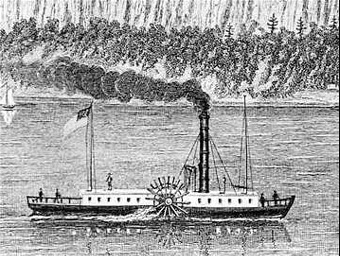 |
| Robert Fulton's Clermont |
Robert Fulton (1765-1815) took what others had already done with steam
power and made it into a successful commercial venture. Fulton made
steamboats a reliable means of water transportation. Born November
14, 1765 in Pennsylvania, Fulton developed his artistic talents as a youth.
He went to Philadelphia at age 17 and took up an apprenticeship with a
jeweler. By the age of 21 he was able to provide for his widowed
mother and his sisters and still have enough money to move to England where
he studied with a well regarded painter, Benjamin West. Once established
Fulton turned his creativity to inventing. He designed proposals
for canal locks, rope making machines and, in 1797 for a submarine.
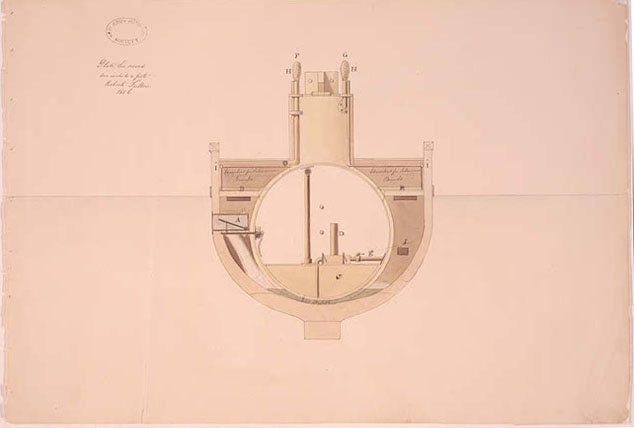 |
| A cross section drawn by Robert Fulton of his submersible
the Nautilus. From Library of Congress, Robert Fulton (1765-1815).
Interior Chambers for Crew, Ballast, and Submarine Bombs. Graphite,
ink and watercolor on paper, 180. |
He offered the French government his services for the development of
a military submarine but was rejected. In 1800, the undeterred Fulton
launched the Nautilus using his own resources. Shortly thereafter
he met up with the American minister to France, Robert Livingston and they
collaborated on developing a reliable steamboat design to take advantage
of Livingston's twenty year steamboat navigation monopoly that he secured
from New York State.
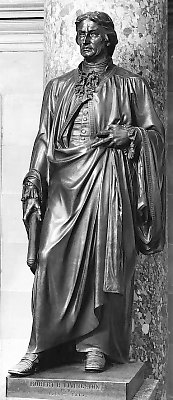
The Fulton-Livingston Collaboration
Robert Livingston (1746-1813) was born in Clermont, New York to a wealthy
family. Livingston studied law as a young man and passed the bar
in 1770. He was an active participant in the Continental Congress
at Philadelphia, serving on committees including finance, foreign affairs,
and judicial affairs. He served on the committee that drafted the
Declaration of Independence. In 1777 Livingston helped draft New
York's constitution and was the state's first chancellor. The Articles
of Confederation created the Department of Foreign Affairs and Livingston
was appointed its secretary where he served with distinction at the Paris
Peace Conference during 1782-1783. Livingston administered the oath
of office to George Washington on April 30, 1789. President Thomas
Jefferson appointed him as minister to France where he negotiated the 1803
Louisiana Purchase. It was in Paris that Livingston made the acquaintance
of Fulton and they began their steamboat collaboration. The men named their
first boat Clermont after Livingston's birthplace and ancestral
home.
Branching Out...
To follow the journey of the New Orleans on its journey along the
Ohio and Mississippi Rivers, go to the American Bottom, East St. Louis
Environment historical narratives. |
|
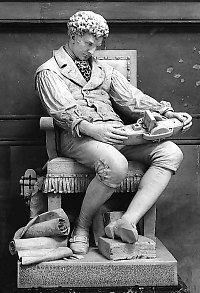 |
Robert Livingston Statue, Bronze by Erastus Dow Statue
of Robert Fulton, Marble by Howard Roberts Palmer. Given in 1889;
located in Statuary Hall, United States Capitol.
|
Soon after Fulton successfully sailed his steamer, the Clermont,
up the Hudson River in 1807 he began to consider using steamboats on the
Mississippi. He and Livingston were able to secure an eighteen year
monopoly from the territory of Orleans (soon to become Louisiana in 1812)
that would only allow their steamboats in the mouth of the Mississippi.
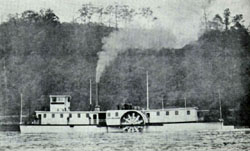 |
| This is a 1911 replica of the original New Orleans built
to celebrate the first steamboat down the Ohio and Mississippi. |
The New Orleans
Steamboat technology was already more than twenty years old, but no one
had yet incorporated it into a successful commercial venture. The
Fulton-Livingston collaboration would be the first. In 1809 they
sent Nicholas Roosevelt and his wife Lydia to explore the Ohio and Mississippi
Rivers for the possible use of steamboats. After determining that
it was feasible Fulton made plans for the construction of a steamboat that
would be the first to venture onto these western rivers. The boat,
the
New Orleans, was 148 feet long, 32 feet wide, with a twelve
foot draft. Fulton built it in Pittsburgh during 1810-1811.
 How Steamboats developed...
How Steamboats developed... How Steamboats developed...
How Steamboats developed...



